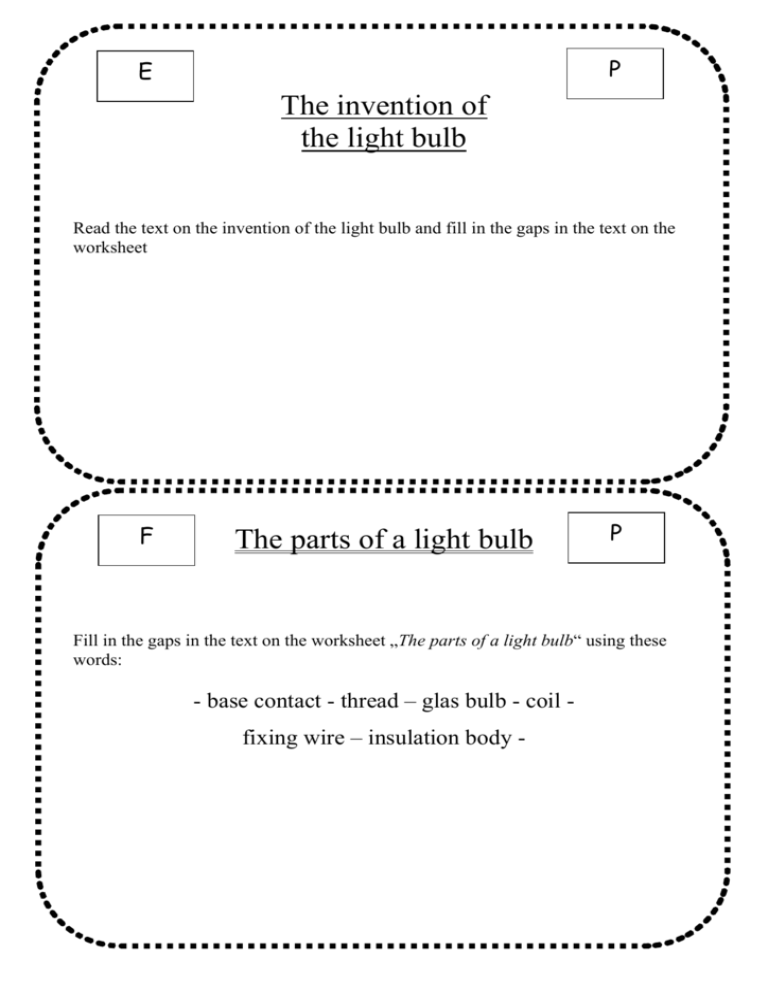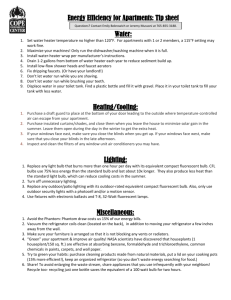The invention of the light bulb The parts of a light bulb
advertisement

P E The invention of the light bulb Read the text on the invention of the light bulb and fill in the gaps in the text on the worksheet F The parts of a light bulb P Fill in the gaps in the text on the worksheet „The parts of a light bulb“ using these words: - base contact - thread – glas bulb - coil fixing wire – insulation body - G The energy saving bulb P 1. Find out what an energy saving lamp consists of and how it works. 2. Use the following words to fill the gaps on the worksheet. - electronic transformer – base switch - coil - glass tube – phosphor film – mercury steam 3. Answer the questions on the worksheet. H Material: - cable - plug - tools W Extension cable wire insulation cable cover wire Tasks: 1. Make an extension cable and show it to me so that I can check it. 2. After this draw a) a cross section of the plug b) a cross section of the cable with the correct colours. 3. Label the parts. Safety plug There are two metal contacts in safety sockets, the safety contacts. They are connected to the green and yellow cable, the earth wire. In a dangerous situation the earth wire diverts the electricity and causes a short circuit of the fuse. Take note of the following: - The wires which conduct the electricity are brown (black) and blue and the earth wire is green and yellow. - The braids at the ends of the wires are secured with press sleeves. The screws on the sleeves must be tight, so that a safe contact is ensured. A loose contact can cause sparks to fly and can cause a cable fire. - The yellow and green earth wire must be longer than the other two. To do this you lay it in a loop inside the plug. Should the cable be pulled out of the plug this ensures that the conducting wires will come out first before the earth wire comes out. - The cable is additionally secured to the casing with a bridge. If the cable is pulled the bridge offers additional support. bridge loop safety contacts earth wire The invention of the light bulb The German-American ____________________________ was the first person to concern himself with the electric ________________________. He pumped the air out of the___________________ and using electricity made a ___________________ thread glow brightly. However the inventor of the first real light bulb was __________ __________________. In his laboratory in Menlo Park near ___________________ he first tried to use filaments made of carbonized ________________________. ____________________ was particularly suitable. After more than a year of experimenting he finally succeeded in making a light bulb _________________. It burned for _____ hours. His next bulb with a filament of carbonized _________________. It burned for 170 hours. Edison’s ________________________ had a great advantage over all the earlier attempts at making bulbs: Its filament was as thin as a____________________ and therefore needed only a very small______________. Around 1900 the bulbs with carbonized filaments were replaced by _______________ . In the meantime it had been possible to produce a durable filament from the hard and rigid _______________metal. Today ____billions of light bulbs are produced all over the world, of which ___________ billions are ______________. If all the bulbs produced in a year were laid down end to end how many times would they fit round the earth?(a bulb is an average of 10 cm in length) ________________ The parts of a light bulb 1. Label the parts of the light bulb and colour the conducting parts red. 2. Colour the electrical circuit red. The energy saving bulb The energy saving lamp consists of two parts: a phosphorescent tube and an electronic transformer. The phosphorescent tube consists of glass. On the inside the glass tube has a thin layer of phosphorescent material. This is why it looks white. There is mercury steam and small amounts of noble gases inside the tube. electronic transformer But the phosphorescent material will not light up on its own. And you will want to be able to switch the lamp off. This is why we need the transformer. In principle it produces only a single current, that is electrons (small negatively charged particles). The electrons “fly” through the mercury steam. When they collide with a mercury particle a streak of UV light is produced. UV light (ultraviolett light) cannot be detected by the human eye. However when the streaks of UV light hit the layer of phosphor they are transformed into visible light. Since the energy saving bulb does not have a filament to produce light like a normal light bulb it does not become so hot. A normal light bulb also produces heat and therefore requires a lot of energy. The energy saving bulb 1. Where is the electricity which flows through the mercury steam produced? ________________________________________________ 2. Explain how light is produced in the mercury steam. ____________________________________________________________ ____________________________________________________________ ____________________________________________________________ 3. What is the purpose of the layer of phosphor? ____________________________________________________________ ____________________________________________________________ 4. Why should broken energy saving bulbs not be put into the normal household rubbish? ___________________________________________________ ____________________________________________________________ 5. Why does an energy saving bulb use less energy than a normal light bulb? _________________________________________________ ____________________________________________________________ ____________________________________________________________








